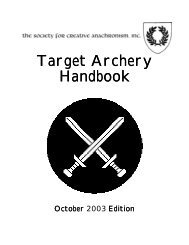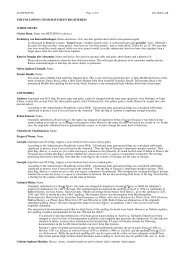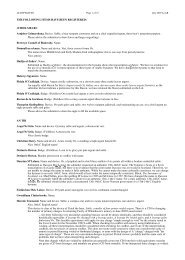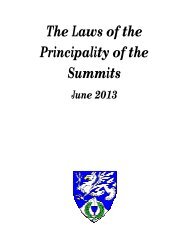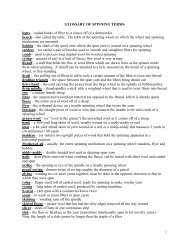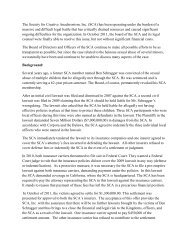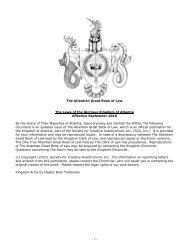The Standards for Evaluation of Names and Armory - SCA Heraldry
The Standards for Evaluation of Names and Armory - SCA Heraldry
The Standards for Evaluation of Names and Armory - SCA Heraldry
Create successful ePaper yourself
Turn your PDF publications into a flip-book with our unique Google optimized e-Paper software.
<strong>The</strong> <strong>St<strong>and</strong>ards</strong> <strong>for</strong> <strong>Evaluation</strong> <strong>of</strong> <strong>Names</strong> <strong>and</strong> <strong>Armory</strong>:<strong>The</strong> Rules <strong>for</strong> Submissionsetc.) <strong>of</strong> the armorial design must be documented as appropriate <strong>for</strong> the armorial style <strong>of</strong> a single time <strong>and</strong>place within the temporal scope <strong>of</strong> the Society. Elements which would be considered a step from periodpractice under the Core Style rules may only be used under the Individually Attested Pattern rules whendocumented as being used in the time <strong>and</strong> place as the rest <strong>of</strong> the submission.Non-European armorial designs <strong>of</strong>ten do not fit into the core style rules, <strong>and</strong> thus may need to use theIndividually Attested Pattern rules in order to be registered.B. Blazon <strong>and</strong> Emblazon: <strong>The</strong> image <strong>of</strong> the armory is known as the emblazon, <strong>and</strong> the written heraldicdescription <strong>of</strong> the image is known as the blazon. We register the emblazon, rather than the blazon. Anydiscrepancies between the image <strong>and</strong> the description will be resolved by changing the description to match theimage. <strong>The</strong> Laurel <strong>of</strong>fice reserves the right to change the description <strong>of</strong> an image at any time, even afterregistration. <strong>The</strong> image will never be changed by the Laurel <strong>of</strong>fice. For this reason, we do not consideralternate emblazons included with a submission.C. Reproducibility: We require that the emblazon be describable in heraldic terms. This means that thesubmitted emblazon must be reproducible by a competent heraldic artist, with only normal heraldic variation,from the written blazon. Designs which depend on careful alignment <strong>of</strong> items in a way that cannot be reliablyblazoned using st<strong>and</strong>ard period heraldic terms will not be registered. This is discussed in more detail in A.3.Fbelow. Designs which use elements (charges, postures, orientations, tinctures, arrangements, etc.) that cannotbe blazoned using st<strong>and</strong>ard period heraldic terms will not be registered.D. Recognizability: Because we register the image <strong>and</strong> not the words, we require that the elements in the imagebe recognizable from their appearance. We are willing to give some allowance <strong>for</strong> poor drawing, butdepictions which are ambiguous as to tincture, the identity <strong>of</strong> a charge, the posture or orientation <strong>of</strong> anelement, the arrangement <strong>of</strong> a group, etc. cannot be reliably blazoned <strong>and</strong> will be returned <strong>for</strong> a redraw. Thisis discussed in more detail in A.2.C below.A.2. <strong>Armory</strong> ContentA. Definitions: Armorial elements include tinctures, charges, lines <strong>of</strong> division, complex line treatments,postures/orientations, arrangements, <strong>and</strong> the like. Essentially, each piece <strong>of</strong> an armorial submission is anelement.On first registration <strong>of</strong> any particular element, documentation must be presented that the element <strong>and</strong> itsdepiction may be registered. This means presenting evidence that the element is eligible to be registered <strong>and</strong>that the specific depiction is attested or is otherwise compatible with period style. Elements which have beenregistered without comment in the last decade or are listed in one <strong>of</strong> the Appendices as acceptable elementsdo not usually need to be documented in a new submission. Items which have not been registered in over adecade, have only been registered a few times, or have recent registrations only via the Gr<strong>and</strong>father Clausemay need to be documented. Occasionally new research will require new documentation <strong>of</strong> a more recentlyregistered element.B. <strong>St<strong>and</strong>ards</strong> <strong>for</strong> Elements: To be used in armorial submissions without penalty, armorial elements must meetone <strong>of</strong> the following st<strong>and</strong>ards.1. Attested Elements: Armorial elements are registerable if they are attested in period European armory.Designs found in a period roll <strong>of</strong> arms or a treatise on armory meet this st<strong>and</strong>ard, even if it is unclear fromthe treatise if the element was used in actual heraldry. Elements used in arms, in badges, <strong>and</strong> in crests allmeet this st<strong>and</strong>ard. Elements must be used <strong>and</strong> combined in the same ways they were used in period<strong>St<strong>and</strong>ards</strong> <strong>for</strong> <strong>Evaluation</strong> <strong>of</strong> <strong>Names</strong> <strong>and</strong> <strong>Armory</strong> – April 29, 2012 - Page 36 <strong>of</strong> 73



